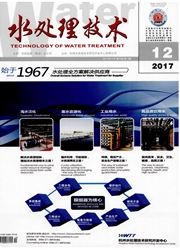

 中文摘要:
中文摘要:
厌氧氨氧化作为一种高效低廉的生物脱氮技术,在高氨氮、低C/N比废水处理过程中显示出无比的优越性。但是,厌氧氨氧化反应过程中会生成大约11%的硝态氮,在处理高浓度含氨废水时,出水总氮可能达不到行业接管排放标准的要求。反硝化技术作为硝态氮脱除的有效手段,联合反硝化技术势必有利于提高氮素的去除率。针对生成的硝态氮问题,从碳源需求角度,基于短程硝化-厌氧氨氧化联合工艺与反硝化技术实现高效生物脱氮的工艺组合形式进行了介绍,提出了前置反硝化、半反硝化和后置反硝化联合脱氮工艺。并对这些组合工艺的特点、优劣及应用情况进行了简要分析。最后对厌氧氨氧化联合高效脱氮工艺运用于低C/N比废水处理的研究重点进行了展望。
 英文摘要:
英文摘要:
As an efficient and cheap biological nitrogen removal technology, ANAMMOX showed great advantages in treating high NH4+-N and low C/N ratio wastewater. Meanwhile, about 11% NO3+-N could be produced in the ANAMMOX process. In the treatment of high-concentration ammonia wastewater, the effluent TN concentration could not meet industrial pipe connection discharge standards. As an effective NO3+-N removal process, combined denitrification technology would certainly benefit to improve the nitrogen removal efficiency. As to NO3+-N generated from ANAMMOX, from the perspective of carbon demand source (C/N ratio), a combined process of efficient biological nitrogen removal was introduced based on the combination ofpartialnitrification-ANAMMOX process and denitrifieation technology, and a combined nitrogen removal process ofpre-denitrification, partial denitrification and post denitrification was proposed. The characteristics, advantages, disadvantages and the applications of these combined processes were analyzed. Finally, the future research prospects and potential applications of ANAMMOX combined with nitrogen removal process in low C/N ratio wastewater treatment were discussed.
 同期刊论文项目
同期刊论文项目
 同项目期刊论文
同项目期刊论文
 期刊信息
期刊信息
